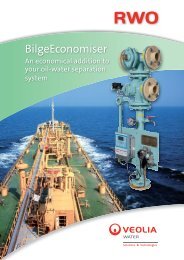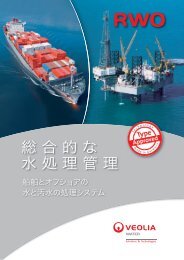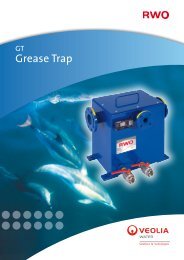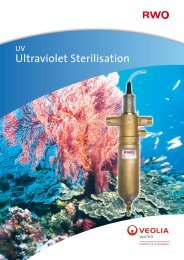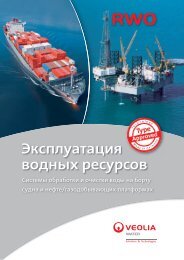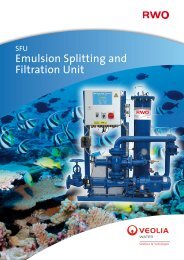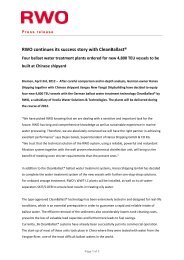the IHS Ballast Water Guide - RWO Marine Water Technology
the IHS Ballast Water Guide - RWO Marine Water Technology
the IHS Ballast Water Guide - RWO Marine Water Technology
You also want an ePaper? Increase the reach of your titles
YUMPU automatically turns print PDFs into web optimized ePapers that Google loves.
Sponsored by <strong>IHS</strong> Fairplay Solutions <strong>Guide</strong> to <strong>Ballast</strong> <strong>Water</strong> Treatment Systems<br />
Crystal<strong>Ballast</strong><br />
Auramarine 2 3<br />
The Crystal<strong>Ballast</strong> treatment system<br />
from Auramarine is based on a two-step<br />
process, with an automatic filter to remove<br />
sediment and larger organisms followed<br />
by an intensive medium-pressure UV unit<br />
to disinfect and destroy smaller plankton,<br />
bacteria and pathogens. It is a scalable<br />
system with versions available with flow<br />
rates varying from 250m 3 /h to 3,000m 3 /h.<br />
Systems can be run in parallel operation.<br />
All organisms and particles removed by <strong>the</strong><br />
filter are continuously returned to <strong>the</strong> sea<br />
at <strong>the</strong> ballasting site. The use of automatic<br />
filtration enables <strong>the</strong> treatment dose to<br />
be reduced, leading to savings in energy;<br />
it also helps reduce <strong>the</strong> size of <strong>the</strong> system.<br />
The automatic filter is bypassed during <strong>the</strong><br />
deballasting operation.<br />
<strong>Ballast</strong> water is treated using <strong>the</strong> complete<br />
process during ballast water intake and<br />
re-treated during ballast water discharge<br />
through <strong>the</strong> UV reactor only. Re-treatment<br />
during discharge is necessary to eliminate<br />
possible regrowth of bacteria in ballast tanks<br />
due to cross contamination or incomplete<br />
intake disinfection.<br />
The Crystal<strong>Ballast</strong> Active Flow Control<br />
(AFC) system keeps <strong>the</strong> flow within<br />
<strong>the</strong> overall system’s maximum rated<br />
treatment capacity without <strong>the</strong> need for<br />
manual intervention during ballasting or<br />
deballasting. The AFC also ensures that<br />
<strong>the</strong>re is adequate counter pressure for<br />
<strong>the</strong> filter during <strong>the</strong> cleaning cycles and it<br />
controls <strong>the</strong> ballast water flow during <strong>the</strong><br />
ultraviolet reactor heating periods. The flow<br />
data is logged in <strong>the</strong> memory of <strong>the</strong> ballast<br />
water treatment system’s programmable<br />
logic controller (PLC) along with <strong>the</strong> UV<br />
treatment information.<br />
BalClor<br />
Sunrui 2 7<br />
The BalClor BWMS from Sunrui treats<br />
ballast water through pre-filtration followed<br />
by disinfection using sodium hypochlorite<br />
solution (an active substance produced by<br />
an electrolytic process during ballasting) and<br />
neutralisation at deballasting using a sodium<br />
thiosulphate solution.<br />
The water is filtered by an automatic<br />
backwashing filter with 50µm screen to<br />
remove most marine organisms.<br />
For <strong>the</strong> disinfection stage, a small side<br />
stream of <strong>the</strong> filtered ballast water is delivered<br />
to an electrolytic unit to generate a high<br />
concentration of oxidants in a mainly sodium<br />
hypochlorite solution. The oxidants are <strong>the</strong>n<br />
injected back into <strong>the</strong> main ballast stream to<br />
provide effective disinfection.<br />
As a very effective germicide, <strong>the</strong> sodium<br />
hypochlorite solution can be kept in <strong>the</strong><br />
ballast water for a time to effectively kill<br />
<strong>the</strong> plankton, spores, larvae and pathogens<br />
contained in <strong>the</strong> ballast water.<br />
For <strong>the</strong> neutralisation stage <strong>the</strong> total<br />
residual oxidant level of <strong>the</strong> treated ballast<br />
water is monitored and kept at 0.1ppm. If<br />
it remains above this level, <strong>the</strong> neutraliser<br />
solution, sodium thiosulphate, is added<br />
automatically into <strong>the</strong> ballast pipe at <strong>the</strong><br />
deballasting stage to counteract residual<br />
oxidants instantly. If it is below this level, <strong>the</strong><br />
treated ballast water is discharged ge ged ge di direct directly. ctly. ly<br />
Blue Seas and Blue World ld<br />
Envirotech<br />
2 7<br />
Envirotech’s BlueSeas and BlueWorld also<br />
make use of use filtration (50µm), seawater<br />
electrolysis and sodium thiosulphate<br />
neutralisation treatment upon uptake.<br />
Its maker claims <strong>the</strong> system is energy-<br />
© <strong>IHS</strong> Global Limited 2012 15<br />
012_037_CorrectedBW1204.indd 15 01/08/2012 15:30:53



